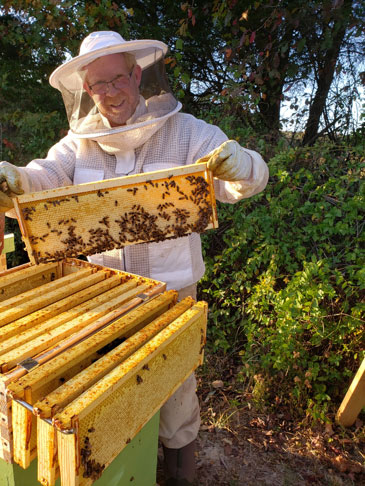The fourth quarter of my first year of beekeeping saw a slowdown in activity as preparations are made heading into winter.
I started October with a decision on what to do with the two full honey supers. Of my four hives, one was smaller and was still in a single deep and I was concerned about it having enough resources to get through winter. So the first super will be placed on this hive to bolster it chances of making it through to spring. If it does make it through the winter, I plan on re-queening it in hopes of making it more productive.

I had originally thought I would freeze the frames from the second honey super to have on hand if needed later. But my other three hives were in really good shape having filled out their two deeps almost completely with honey. Instead, fellow SIBA member, Roger Rickabaugh, suggested I harvest and bottle that honey thereby closing the loop on my beekeeping experience. I was a little concerned because the syrup feeders were on the hives during part of the interval this honey was produced by the bees but I was assured it was edible and it would be fine for home use and to give away to family and friends. And I could still put it out for the bees in a public feeder if the need arises.

On October 8th, I pulled the supers with some help from Roger. We stood each super on its side and then used a leaf blower to remove the bees from between the frames. With the bees removed, the supers were covered and secured. We also did Mite checks until we lost the light. One of the hives had a count of 1 mite and we went ahead and treated using the oxalic-acid/glycerin method.
On Sunday, October 13 th , Roger brought his extraction gear to my home and we processed the 10 frames. My whole family was excited to watch the honey being collected.


To prepare for winter, I cut foam panels to close off my screened bottom boards. I measured and cut these in my shop using a new a new bottom board.

But when I got out the apiary, I found that the bottom boards in my hives had twisted and groove for the bottom board had closed from the pressure of the ratchet strap that held all the hive components together. I had to make some adjustments to get everything to fit. In the future, I am going to add a cross member across the center that should prevent the bottom edges of the sides from pulling in when the strap is put on.

I am in process of making Candy boards and will put them on the next chance I get.
I learned a lot this year, not least of which is, I still have a lot to learn. Starting beekeeping reminded me of having my first child; wanting to do everything right and worrying about every decision or action trying to keep them healthy. Looking back over the year, I believe things went fairly well. There are some minor things I would do differently which I have mentioned in my previous reports. One opportunity I missed was using one hive to help another along. This occurred when one hive was drawing out frames quickly while another was doing so slowly. Given the value of having drawn comb, I wish I had leveraged the productive hive by moving some of those drawn frames to the slower hives. I will do that next year if circumstances permit it.
I am quite thankful for the help I received from the Beekeepers of Indiana and the jump-start program, from my mentor Jeff Montag, from my friend Roger Rickabaugh and all the other friendly and helpful members of the Southeast Indiana Beekeepers Association.




1 Response